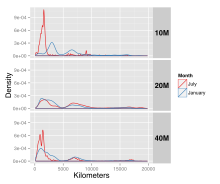

| Developer(s) | Joe Taylor, K1JT |
|---|---|
| Initial release | 2008 |
| Written in | C++ (GUI), Fortran, C [1] |
| Operating system | Cross-platform |
| Available in | English, Italian, Spanish, French, German, Japanese, Polish, Portuguese, Russian |
| Type | Amateur radio and DSP |
| License | GPL |
| Website | wsjt.sourceforge.io |
WSPR (pronounced "whisper") is an acronym for Weak Signal Propagation Reporter. It is a protocol, implemented in a computer program, used for weak-signal radio communication between amateur radio operators. The protocol was designed, and a program written initially, by Joe Taylor, K1JT. The software code is now open source and is developed by a small team. The program is designed for sending and receiving low-power transmissions to test propagation paths on the MF and HF bands.
WSPR implements a protocol designed for probing potential propagation paths with low-power transmissions. Transmissions carry a station's callsign, Maidenhead grid locator, and transmitter power in dBm. The program can decode signals with a signal-to-noise ratio as low as −28 dB in a 2500 Hz bandwidth.[2] Stations with internet access can automatically upload their reception reports to a central database called WSPRnet, which includes a mapping facility.
The type of radio emission is “F1D”, frequency-shift keying. A message contains a station's callsign, Maidenhead grid locator, and transmitter power in dBm.[3] The WSPR protocol compresses the information in the message into 50 bits (binary digits). These are encoded using a convolutional code with constraint length K = 32 and a rate of r = 1⁄2.[3][4] The long constraint length makes undetected decoding errors less probable, at the cost that the highly efficient Viterbi algorithm must be replaced by a simple sequential algorithm for the decoding process.[3]
The standard message is <callsign> + <4 character locator> + <dBm transmit power>; for example “K1ABC FN20 37” is a signal from station K1ABC in Maidenhead grid cell “FN20”, sending 37 dBm, or about 5.0 W (legal limit for 630 m). Messages with a compound callsign and/or 6 digit locator use a two-transmission sequence. The first transmission carries compound callsign and power level, or standard callsign, 4 digit locator, and power level; the second transmission carries a hashed callsign, 6 digit locator, and power level. Add-on prefixes can be up to three alphanumeric characters; add-on suffixes can be a single letter or one or two digits.


The protocol was designed to test propagation paths on the LF, MF and HF bands. Also used experimentally at VHF and higher frequencies.
Other applications include antenna testing, frequency stability and frequency accuracy checking.
Usually a WSPR station contains a computer and a transceiver, but it is also possible to build very simple beacon transmitters with little effort.
For example a simple WSPR beacon can be built using the Si 570,[5] or Si 5351.[6] The Raspberry Pi can also be used as WSPR beacon.

An accurate clock is essential both for transmission and decoding of received signals.
In May 2021, aerospace engineer Richard Godfrey suggested examining historical WSPR data as a way to define the flight path of Malaysia Airlines Flight 370 on 8 March 2014.[7] In November 2021, Godfrey stated his belief that his analysis indicates the aircraft flew in circles for around 22 minutes in an area 150 nautical miles (280 km; 170 mi) from the coast of Sumatra before vanishing, later proposing a search area centered around 33°10′37″S 95°18′00″E / 33.177°S 95.3°E / -33.177; 95.3.[8][9][10][11]
As of March 2024, the validity of Godfrey's claim is yet to be established.[12] On 6 March 2024 the BBC documentary Why Planes Vanish: The Hunt for MH370 examined Godfrey's claim and reported that scientists at the University of Liverpool were undertaking an analytical study of the possibility of using WSPR technology to locate the missing aircraft. The University stated they would release their results within 6 months.[13][14]
WSPR was originally released in 2008.
GDTAAA WSPRnet MH370 Analysis Flight Path Report (Self-published, Dropbox)
|
Amateur radio digital modes
| ||
|---|---|---|
| Frequency-shift keying (FSK) |
|
|
| Multiple frequency-shift keying (MFSK) |
| |
| Phase-shift keying (PSK) |
| |
| COFDM |
| |
| Non-traditional digital modes |
| |
|
| |
|---|---|
| Amateur and hobbyist |
|
| Aviation (aeronautical mobile) |
|
| Land-based commercial and government mobile |
|
| Marine (shipboard) |
|
| Signaling / Selective calling |
|
| System elements and principles |
|
|
| |||||||
|---|---|---|---|---|---|---|---|
| Activities |
| ||||||
| Culture |
| ||||||
| Governance |
| ||||||
| Modes of communication |
| ||||||
| Technologies |
| ||||||
| Related |
| ||||||